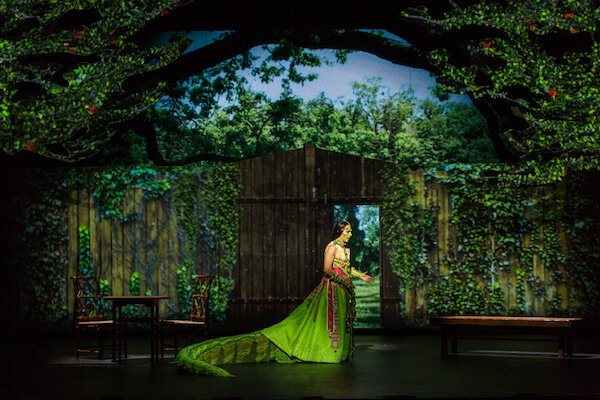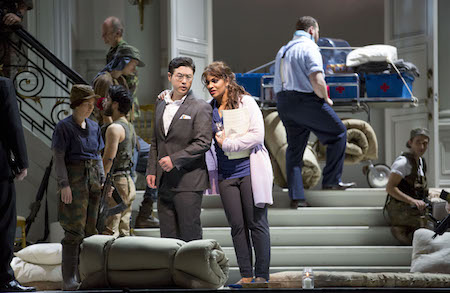Anthony Roth Costanzo and Kiera Duffy as Orfeo and Euridice. | ERIN BAIANO
In May, MasterVoices presented two performances of “Orphic Moments,” a musical conflation of Gluck’s “Orfeo ed Euridice” with Matthew Aucoin’s cantata “Orphic Moments” at the Rose Theater at Jazz at Lincoln Center. “Orphic Moments” is a 16-minute internal monologue for Orpheus spotlighting that crucial moment where he must choose whether to ignore the pleas of his despairing wife’s shade or look back at her and lose her forever.
This pairing of 18th century opera and 21st century post-modernism was originally presented to full houses and critical acclaim in March 2016 at National Sawdust in Williamsburg, Brooklyn as a vehicle for countertenor Anthony Roth Costanzo, who co-produced the event. The Aucoin cantata was presented first as a prologue followed by the Gluck opera (a feast was consumed in between the musical treats). For the MasterVoices presentation, the Aucoin cantata was interpolated into the penultimate scene of the Gluck opera (no dinner this time).
The National Sawdust cast was reassembled, including Costanzo as Orfeo, Kiera Duffy as Euridice, Lauren Snouffer as Amore, with dancer Bobbi Jene Smith and violinist Keir GoGwilt joining them for the Aucoin interlude. (Smith replaced Duffy as a dancing but silent Eurydice while GoGwilt played his violin obbligatos onstage left.) Ted Sperling conducted the MasterVoices chorus and the Orchestra of St. Luke’s. A minimalist staging by Zach Winokur with scenic elements by Douglas Fitch put the opera in contemporary dress evoking downtown hipsters attending a wedding in Provincetown.
MasterVoices combines Gluck and Matthew Aucoin; English Concert at Carnegie
The chorus was in fantastic voice, and Sperling and the OSL displayed remarkable musical versatility. Sperling offered a clear, elegant reading of a streamlined Italian version of Gluck’s “Orfeo” then shifted gears effortlessly into a more layered, dissonant modernism for the Aucoin. Duffy’s lean but pure soprano brought urgency to Euridice’s plaints. Snouffer delighted as Amore, entering as a janitress sweeping away the debris from the aborted wedding feast, then stripping off her work uniform to reveal a snappy red pantsuit. Her scintillating soprano brought equal parts rose-colored vibrancy and soaring brilliance to Amor’s music.
Costanzo’s voice proved as double-sided as the musical program. In the upper reaches, his countertenor has a seraphic purity that caresses the ear and provides balm to the soul. In the lower register, the tone loses the roundness and float, becoming narrowly pointed and nasal. More insistent declamatory passages in the middle register sounded like a character voice countertenor singing the Sorceress in Purcell’s “Dido and Aeneas” or a buffo role in Monteverdi opera. This does not jibe with my prior experiences of Costanzo’s singing but his sensitivity to text and musical intelligence were consistent both in the Gluck and the Aucoin.
Aucoin’s cantata set to an English text by the composer suggests that Orpheus deliberately chooses to lose Eurydice knowing that his loss as a man will make him a greater artist — his laments will stem from life experience. But the sudden jarring shift from Gluck’s clear 18th century classicism to Aucoin’s restless ostinatos, shifting harmonies, and darkly layered, often percussive chamber orchestra writing resulted in a “Toto, I don’t think we’re in Kansas anymore” moment of musical dislocation. (I find Berio’s completion of Puccini’s “Turandot” has a similar effect of jumping over centuries with discordant musical styles.) I feel that Gluck has dramatized that moment fully in his “Orfeo” — the interpolation of the Aucoin cantata kills the dramatic momentum making a concise opera unwieldy and diffuse. I think both pieces are served more effectively standing alone as integral works.
The English Concert was at Carnegie Hall on March 25 with another edition of its annual Handel opera in concert series. This year, it was Handel’s first English success, “Rinaldo” (1711). In this “magic opera,” Handel recycled all of his best tunes from his early Italian career (and reputedly purloined tunes from other composers). “Rinaldo” was famously revived in the early 1980s for Marilyn Horne in the title role, providing a star-making breakthrough role for a young Samuel Ramey as the villainous Argante.
The Carnegie Hall concert presentation lacked that kind of larger-than-life star power and bravura vocalism. The magic was in the overall musical presentation and style, not in the onstage spectacle. Handelian Wizard-in-Chief Harry Bicket again showed a precise understanding of how Handel builds drama by contrasting musical modes — each da capo aria has its own stylistic profile that creates a specific mood that the next aria expands or contrasts. Recitatives carry the dramatic message, which the arias deepen and explore.
Countertenor Iestyn Davies, fresh off of Broadway’s “Farinelli and the King,” was a plangent but unheroic Rinaldo. His tone is pure and elegiac with a soft center, decent but less than brilliant agility, and a weak lower register. This sound is perfect for adagios like “Cara Sposa” but the fireworks of “Or la tromba” failed to ignite. The original Rinaldo was Nicolini, an alto castrato with a voice that had a boy soprano’s high register but the depth, power, and range of an adult male. A female contralto like a Horne or PodleÅ› sang this repertory with more tonal thrust and dramatic power as well as greater variety in dynamics and vocal coloration. Davies has one vocal color — gentle, lyrical, and plaintive — that is well-suited to Purcell and certain Britten roles but sounds ineffectual in a bravura Handel hero.
Joélle Harvey’s quicksilver, shimmering soprano proved beguiling in Almirena’s “Lascia ch’io pianga.” Bicket allowed Harvey to interpolate high notes and cadenzas that spotlighted her gleaming upper register in an otherwise medium tessitura role. Canadian coloratura Jane Archibald sang the fierce and wily sorceress Armida with a creamy tone that sailed into the high reaches with insolent ease and matched the harpsichord pyrotechnics in the Act II closer “Vo’ far Guerra.” As Argante, bass-baritone Luca Pisaroni didn’t erase memories of Ramey’s coloratura feats but did evoke him in stage charisma and tonal color. Sasha Cooke as Goffredo provided the rich vocal color lacking in the other countertenors onstage and sang with commendable legato line. Jakub Józef OrliÅ„ski sang Eustazio very musically but was more striking to the eye than the ear. James Hall (Davies’ alternate in “Farinelli and the King”) made appealing sounds as a “Christian Magician.”
Bicket saw that Handel emerged as the star player here with his abundant musical invention placed front and center.


































